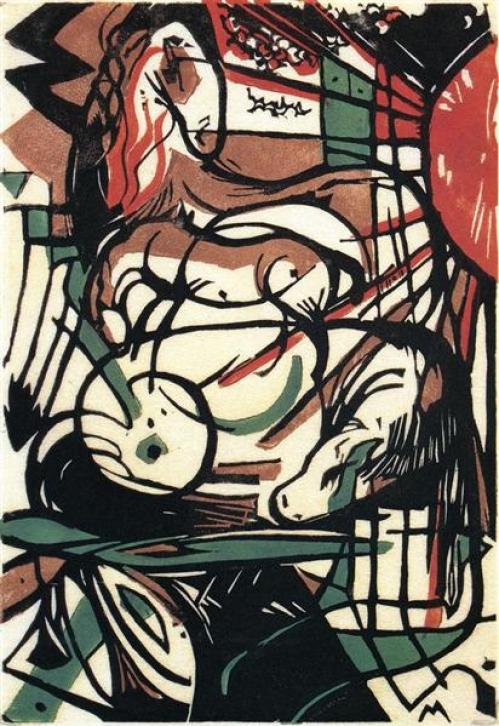
Franz Marc: War Crime: The Assassinated Painter
During his lifetime Franz Marc was widely regarded as one of the most promising German painters of his generation. His death in the First World War was mourned as a bitter loss for the art world. It was also a deep personal loss for his surviving friends, Klee and Kandinsky – his other close friend from the Der Blaue Reiter circle, Macke, had died before him on the battlefield.

As a young student, Marc had intended to study philosophy and theology. Then, in 1900, he decided to become a painter instead, and registered at the Munich Art academy. Marc’s early work was relatively naturalistic, but it showed evidence of his admiration for Van Gogh and Gauguin, whose works he had seen at first hand in Paris. He painted and made some prints and small sculptures.
Most of his subjects came from nature. They were landscapes, a few nudes and, increasingly, the animals that would become so central and distinctive in his work. By around 1908 he was starting to intensify his exploration of the movement, behaviour and character of animals. He would spend hours observing and sketching cows and horses in the Bavarian pastures, and watching deer in the wild. Rehe im Schilf (Deer in the Reeds) of 1909 is a characteristic work of this period.

Marc’s and Kandinsky’s endeavours with the Blaue Reiter were part of the Expressionist search for “origins” and for authenticity. In some ways, these were qualities that Marc recognized in the animal kingdom, away from the stultifying effects of civilization. His woodcut, Geburt der Pferde (Birth of Horses) of 1913 envisages a cosmos in which animals represent the forces of creation.

In the summer of 1913, Marc embarked on a major series of large and increasingly experimental works. The most important of these was his Tierschicksale (Fate of the Animals), as discussed on. Finally, in 1914, just as the war was brewing in Europe, he began to paint almost entirely abstract canvases. An example is Kämpfende Formen (Fighting Forms). The conflict described by the title is a cosmic one of opposite energies, bright and dark, symbolically, good and evil, tumbling and fragmenting in combat with one another.

As he matured as an artist, in keeping with Expressionism’s tendency to deal in universals– fundamental ethical issues and philosophies – Marc’s intellectual concerns were with a future age of “the spiritual” and with the redemptive function of art in the modern society that he and his friends found so shallow and materialistic.
In 1916, Marc was one of the 700,000 men killed in the long battle of Verdun. He was on an exploratory mission when he was fatally wounded, by flying shrapnel. In 1937, when the Nazis waged their bitter campaign against modern art in general and Expressionism in particular, they seized 130 works by Marc from public collections and included some of them in the Entartete Kunst (Degenerate Art) exhibitions. His inclusion was controversial, for Marc was a painter widely held in high esteem and an officer who had died fighting for Germany.
Marc’s Red Deer II was confiscated but later declared a “borderline case” and handed back to the Staatsgalerie in Munich in 1940. Another of his most important paintings, Der Turm der blauen Pferde (Tower of Blue Horses) was removed from the exhibition in response to protests from a German officers’ association. It landed for a time in the hands of Hermann Göring (who hoarded a collection of the “best” of the art that the Nazis defamed) and was last seen in the possession of the regime in 1945.
Franz Marc , Klee , Kandinsky , Expressionism , Städtische Galerie im Lenbachhaus , Bayerische Staatsgemäldesammlungen , Scottish National Gallery Of Modern Art , Kunstmuseum Basel , Staatsgalerie Moderne Kunst , Parkstone International , Art , Painting , Ebook Gallery, Image-Bar , Amazon Germany , Amazon France , Amazon Spain , Amazon Canada , Amazon UK , Amazon Mexico , Amazon India , Amazon China , Amazon Japan , Amazon Italy , Amazon Australia , Kobo , Douban , Google books , iTunes , Proquest , Scribd





